The dedication page to our new poetry book reads:
“Dedicated to the many men who have graduated from Helping Up Mission – you give us courage for the fight. Sic semper draconis”
Here’s the story behind that obscure Latin phrase, as told by our chaplain Vic King.
Have you read The Drowned Vault by ND Wilson? There’s an intriguing Latin family motto hidden in there: sic semper draconis. It’s a play on the Latin phrase sic semper tyrannis, which has a strange and storied history.
“Thus Always to Tyrants”
Sic semper tyrannis was the cry attributed to Brutus at his assassination of Julius Caesar, and in 1776 it was adopted as the official seal of the Commonwealth of Virginia after they declared independence from Great Britain.
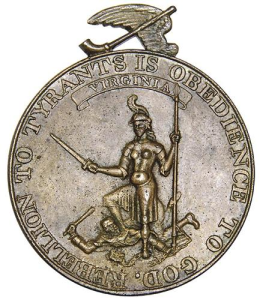
“Rebellion to tyrants is obedience to God.” – A medal coined by the State of Virginia in 1780
Several decades later John Tyler, a Virginian boy who would one day be the tenth president of the United States, led a revolt against his despotic schoolmaster. Tyler and his classmates tied the teacher hand and foot and locked him in a closet at the end of the school day. When the teacher was found and freed, he confronted John Tyler’s father, who dismissed him with the Latin phrase.
John Wilkes Booth’s diary records that he hollered “Sic semper” after shooting Abraham Lincoln in April 1865, referencing Caesar’s assassination. And Timothy McVeigh, who was responsible for the Oklahoma City bombing in April 1995, was wearing a t-shirt with the Latin phrase and a picture of Lincoln. Clearly, the pedigree of the phrase sic semper tyrannis has become less noble over the centuries.
Behind the Tyrants: Dragons
But with his variation, sic semper draconis, Nate Wilson not only revives the spirit of righteous rebellion, he recovers its biblical roots. Our ultimate enemy is not an earthly tyrant, it is a hellish dragon.
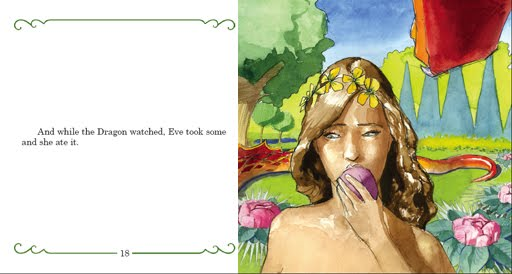
A page from ND Wilson’s picturebook account of Genesis 1-3, The Dragon and the Garden.
It was in the Garden of Eden that a serpent deceived our first mother, and our first father betrayed his Maker, sending our race into a tailspin of shame and ruin. God’s judgment on the serpent is to send him crawling on his belly – the implication being that, before this curse, he had walked. (What do you call a snake with legs? A dragon.)
But God doesn’t leave it at that. He promises Eve that from her line will come a dragon slayer, the Dragon Slayer, who will crush the beast and free his people from the tyranny of sin. The protoevangelium tells the serpent that “he will crush your head, and you will strike his heel.” The dragon will be trampled, but at great pain to the One who does the trampling.
Fast-forward to Revelation 12, where John is given a visionary perspective on Christ’s first coming:
And the dragon stood before the woman who was about to give birth, so that when she bore her child he might devour it.
The scene on the ground in Matthew 2: the tyrant Herod hears rumors that a threat to his throne has been born. That paranoid despot orders the slaughter of all the baby and toddler boys in Bethlehem. Revelation 12 gives the scene in heaven: behind the tyrant was the dragon. The devil was seeking to devour the Christ-child, but he is thwarted, and Jesus and his family escape to Egypt.
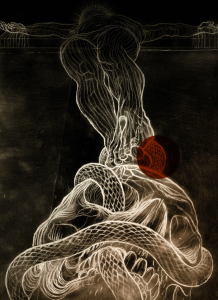
Chris Koelle’s “Protoevangelium”
At the start of Jesus’ ministry, he faces off with the dragon once again. This time, it’s alone in the desert. And again our Lord comes out unscathed. Theologians have made much of Matthew 4 as Jesus’ recapitulation of Israel’s history: Israel went into the wilderness for 40 years to be tested, and so did Jesus. But unlike Israel, Jesus never wavered. He is the new Israel, and he is the second Adam. He lived the life that Adam failed to live, and died the death that Adam (and each of us) deserve, taking the serpent’s strike on the heel… but rising to life on the third day, crushing that dragon’s head.
Here Be Dragons
But the Great Dragon is not the only dragon. We can be, we have been, dragons. In one of the most vivid conversion stories in the world of Narnia, CS Lewis pictures the gift of salvation as being “un-dragoned.” Douglas Wilson (ND Wilson’s father) puts it this way in a lecture on Lewis:
Eustace was miserable as a dragon and discovered that he was utterly unable to heal himself or prepare himself to be healed. When he tried to remove the dragon skin by himself, all he was able to do was get down underneath his dragon skin — to the next layer of dragon skin. And you know while you are reading this passage, beyond any shadow of any doubt, that as long as Eustace was doing his own scraping, it would be dragon skins all the way down.
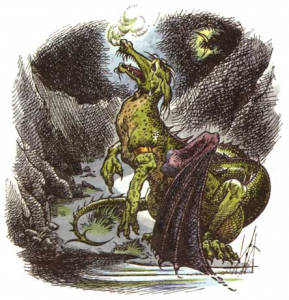
Pauline Baynes’ illustration of Eustace the dragon
What had to happen was Aslan’s work – the lion had to carefully claw the dragon skin off of the boy. Here is how Lewis describes it, in Eustace’s voice:
The very first tear he made was so deep that I thought it had gone right into my heart. And when he began pulling the skin off, it hurt worse than anything I’ve ever felt. The only thing that made me able to bear it was just the pleasure of feeling the stuff peel off. . . .
Well, he peeled the beastly stuff right off — just as I thought I’d done it myself the other three times, only they hadn’t hurt — and there it was lying on the grass: only ever so much thicker, and darker, and more knobbly-looking than the others had been. And there was I as smooth and soft as a peeled switch and smaller than I had been. Then he caught hold of me — I didn’t like that much for I was very tender underneath now that I’d no skin on — and threw me into the water. It smarted like anything but only for a moment. After that it became perfectly delicious and as soon as I started swimming and splashing I found that all the pain had gone from my arm. And then I saw why. I’d turned into a boy again. . . .
After a bit the lion took me out and dressed me . . . in new clothes.
There it is, baptism and all: through faith in Christ, we are un-dragoned. And now, Paul tells us in Ephesians 6, we fight demonic forces with the weapons of the Spirit. We have been given the full armor of God, that we may be able to stand against the schemes of the devil. For we do not wrestle against flesh and blood, but against the rulers, against the authorities, against the cosmic powers over this present darkness, against the spiritual forces of evil in the heavenly places.
In my work as a chaplain at Helping Up Mission, I see a lot of dragon-slaying. I have the privilege of walking with men as they do battle with the dragons of addiction and trauma, sins they’ve done and sins done against them, the spectres of shame and guilt that hound them like the Nazgûl, those deathly riders in Tolkein’s Lord of the Rings. I see men thrust the sword of the Spirit down the dragon’s throat and out the back of its head. I see men walking into new life with freedom from the dragons they had become, and the dragons that were pursuing them.
The story behind the art
I wanted to make that spiritual reality tangible in some way. Here’s what I came up with. I had an image floating around in my head for awhile of an emblem: a manly fellow, somewhere between St. George and Jesus, wrapped about by a dragon as he shoves his sword or spear down its throat and out the back of its head.
I reached out to Chris Koelle, an artist and printmaker in South Carolina. (Chris is perhaps best known for his epic graphic novel versions of The Book of Revelation, The History of Redemption, and Job.) He created this design, which we had printed onto 4” round stickers.
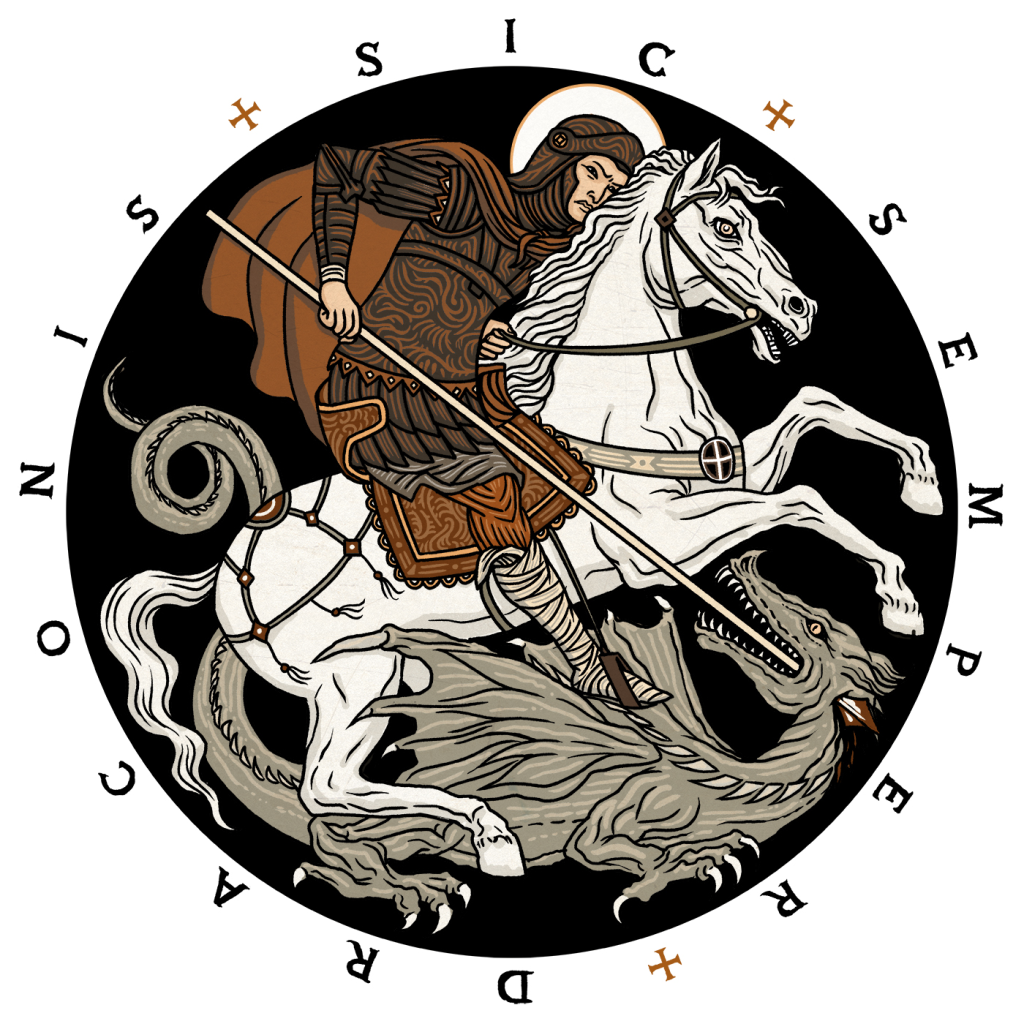
Now, at Helping Up, I give these stickers to the men I counsel. The obscure Latin phrase and the powerful image have become a shorthand, an icon of their struggles and the power of Christ in them.
It’s a struggle we all live with, and in Christ, it’s a fight we can win. Sic semper draconis.